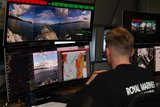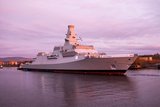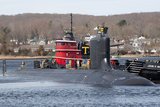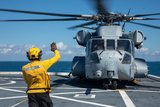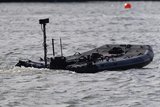Taiwan president watches naval drill as China tensions grow
Taiwan's President Tsai Ing-wen watched naval drills simulating an attack on the island on 13 April, days before Beijing is set to hold live-fire exercises nearby in a show of force.
Relations between self-ruling Taiwan and China have deteriorated since Tsai Ing-wen came to power almost two years ago, largely because she refuses to accept the ‘One China’ formula governing relations.
Beijing regards the island as its territory – to be reunited by force if necessary – even though the two sides split in 1949 after a civil war.
China's growing military is increasingly flexing its muscles and will hold live-fire drills in the week of 16 April in the Taiwan Strait – the narrow waterway separating the Chinese mainland from Taiwan – following weeks of naval manoeuvres in the area.
Tsai boarded the Kee Lung destroyer to supervise as troops practised defending against an attack on the northeastern port of Suao.
It was the first time she has supervised a drill from onboard a warship.
Tsai said on the destroyer's deck after it returned to port as the exercise ended: ‘I believe our countrymen will have great faith in the military's combat capabilities and its determination to defend our country after today's drill.’
Tsai said ‘we are very confident of our military’ when asked to comment on Beijing's planned live-fire drill in the Taiwan Strait.
She added: ‘It's a routine drill that our military will fully monitor and has made relevant preparations.’
Taiwan's Defence Ministry said the exercise was staged in light of a ‘changing international and regional security situation’ to test the military's combat readiness and its ability to defend Taiwanese territory.
Some 20 warships and four F16 fighter jets took part in the drill, one of the largest naval manoeuvres since Tsai took office in May 2016.
Tsai has warned against what she called Beijing's "military expansion" -- the increase in Chinese air and naval drills around the island since she took office in May 2016.
Chinese warplanes conducted 25 drills around Taiwan between August 2016 and mid-December 2017, according to Taipei.
On 12 April, Chinese President Xi Jinping made a surprise visit to naval forces in the disputed South China Sea, where he stressed the ‘urgent’ need to build a powerful navy.
China's sole aircraft carrier, the Liaoning, sailed through the Taiwan Strait on 20 March, the same day that Xi issued a public warning against attempts to ‘separate’ from China.
Xi's naval visit came after a US aircraft carrier sailing though the South China Sea gave a demonstration on 10 April for members of the Philippine government.
Washington recently agreed to allow US defence contractors help Taiwan construct its own submarines, sparking a warning from Beijing to Taipei against ‘playing with fire to burn itself’.
More from Naval Warfare
-
![Hanwha wins Australian government approval to increase its stake in Austal]()
Hanwha wins Australian government approval to increase its stake in Austal
The contract would mean the two shipbuilders can collaborate strategically and enhance shipbuilding capabilities in Western Australia.
-
![Royal Australian Navy sizes up modernisation plans for new and existing capabilities]()
Royal Australian Navy sizes up modernisation plans for new and existing capabilities
The Australian navy is pushing ahead with its efforts to modernise its workforce and capabilities while balancing risky submarine upgrades, ageing Collins-class boats and a shrinking minehunter fleet. Head of navy capability RAdm Stephen Hughes updated Shephard on the force’s progress.
-
![UK to join US Navy’s Virginia-class submarine assembly effort to speed up construction]()
UK to join US Navy’s Virginia-class submarine assembly effort to speed up construction
The expansion of the Virginia-class submarine construction to UK shores could accelerate the project as US shipbuilders continue to fall short of delivery goals.
-
![US Navy seeks new sensors for the CH-53K King Stallion heavy-lift helicopter]()
US Navy seeks new sensors for the CH-53K King Stallion heavy-lift helicopter
The US Navy intends to publish a draft request for proposals in Q2 2026 and conduct an open competition for the supply of new electro-optical and infrared capabilities for the CH-53K heavy-lift helicopter.
-
![NATO naval exercises map out future USV requirements but raise questions on acquisition]()
NATO naval exercises map out future USV requirements but raise questions on acquisition
Uncrewed surface vessels have shifted from a desirable capability to a critical one for navies. But should these systems be bought outright, rented as a service or rapidly built using commercial off-the-shelf components?







